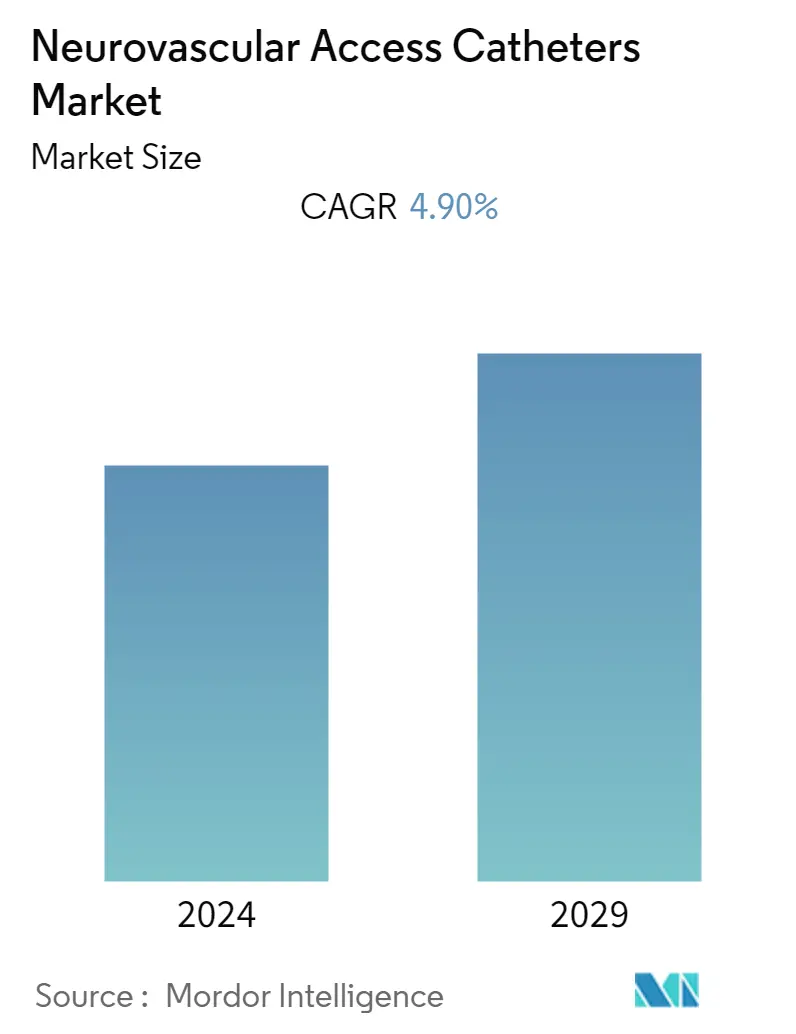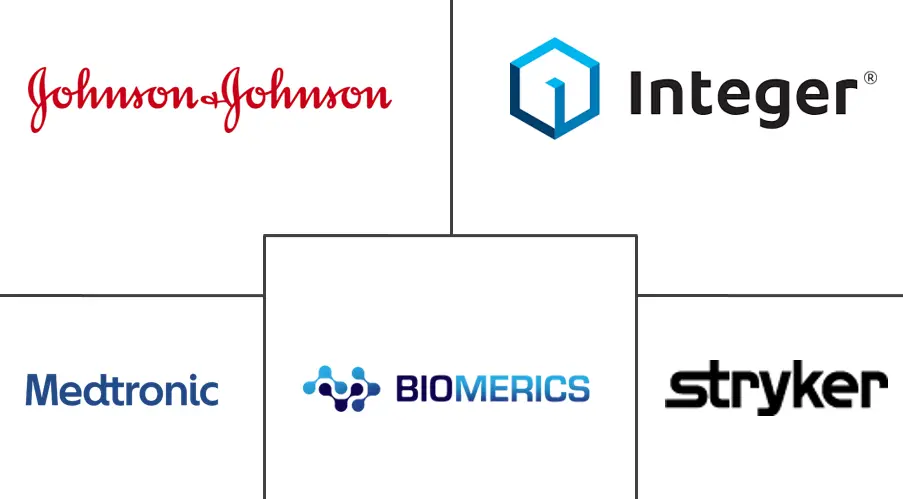Market Size of Neurovascular Access Catheters Industry

| Study Period | 2019 - 2029 |
| Base Year For Estimation | 2023 |
| Forecast Data Period | 2024 - 2029 |
| CAGR | 4.90 % |
| Fastest Growing Market | Asia-Pacific |
| Largest Market | North America |
Major Players
*Disclaimer: Major Players sorted in no particular order |
Neurovascular Access Catheters Market Analysis
During the time frame of the forecast, the neurovascular access catheters market is expected to grow at a CAGR of 4.9%.
COVID-19 had a big effect on the market for neurovascular access catheters because many neurovascular surgeries had to be put off or stopped during the first wave of the pandemic. For example, a February 2021 article in PubMed says that coronavirus affects neurological presentations and health status because neurological patients need to stay in the hospital more often and have a higher risk of death and disability when they get out.Due to the global lockdown, it was hard for patients with neurological problems to get regular checks and treatment, which had a big effect on the market studied.But now that the restrictions have been lifted, the market is likely to grow because neurovascular problems are becoming more common and more people are using neurovascular access catheters.
Market growth is likely to be driven by things like the rise of neurovascular diseases and the improvement of neurovascular catheter technology.For example, according to an article in Frontiers from March 2022, the estimated global incidence of subarachnoid hemorrhage (SAH) is 6.67 per 100,000 people. Each year, SAH affects nearly 500,000 people, and nearly two-thirds of these people live in low- and middle-income countries.Furthermore, technological advances in neurovascular access catheters are expected to drive market growth over the forecast period. For instance, in February 2022, CERENOVUS, an emerging company that focuses on neurovascular care and is part of the Johnson & Johnson Medical Device Companies, launched the EMBOGUARD, a next-generation balloon guide catheter to be used in endovascular procedures, including those for patients with acute ischemic stroke.
Also, research studies and comparisons of the different neurovascular access catheters should help the market grow during the study period. For example, a September 2022 article in PubMed said that a 0.096-inch inner diameter access catheter could be used for neurovascular treatments through both the femoral artery and the radial artery. It had a good rate of technical success and a low rate of problems during the procedure.
So, the studied market is likely to grow over the next few years because neurovascular complications are getting worse, more neurovascular access catheter products are coming out, and more research and development is being done. But problems with biocompatibility are likely to slow market growth for neurovascular access catheters.
Neurovascular Access Catheters Industry Segmentation
As per the scope of the report, neurovascular catheters are used to drain or withdraw unwanted fluid from neurovascular organs to administer medications to the organs or diagnose neurovascular diseases. The Neurovascular Access Catheters Market is Segmented by Product Type (Single Lumen Catheters, Double Lumen Catheters, Multiple Lumen Catheters), Material (Liquid Crystal Polymer, Fluorinated Ethylene Propylene, Other Materials), and Geography (North America, Europe, Asia-Pacific, Middle East and Africa, and South America). The market report also covers the estimated market sizes and trends for 17 different countries across major regions, globally. The report offers the value (in USD million) for the above segments.
| By Product Type | |
| Single Lumen Catheters | |
| Double Lumen Catheters | |
| Multiple Lumen Catheters |
| By Material | |
| Liquid Crystal Polymer | |
| Fluorinated Ethylene Propylene | |
| Other Materials |
| Geography | ||||||||
| ||||||||
| ||||||||
| ||||||||
| ||||||||
|
Neurovascular Access Catheters Market Size Summary
The neurovascular access catheters market is poised for growth over the forecast period, driven by the increasing prevalence of neurovascular disorders and advancements in catheter technology. The market experienced a setback during the COVID-19 pandemic due to postponed neurovascular surgeries, but with the lifting of restrictions, the demand for these catheters is expected to rise. The introduction of innovative products, such as CERENOVUS's EMBOGUARD, and ongoing research into catheter efficacy are contributing to market expansion. Despite challenges related to biocompatibility, the market is supported by the growing incidence of conditions like subarachnoid hemorrhage and ischemic stroke, which necessitate the use of neurovascular access catheters.
The multi-lumen catheter segment is also anticipated to grow, fueled by the rising cases of neurovascular disorders and technological advancements. Product launches and strategic partnerships among key industry players are further propelling market growth. North America is expected to hold a significant share of the global market, attributed to the high prevalence of neurovascular conditions and a robust healthcare infrastructure. The region's market growth is bolstered by the introduction of new products and successful clinical applications, such as the use of Vena BDAC technology in Canada. The competitive landscape is characterized by major players like Stryker Corporation, Medtronic Plc, and Johnson & Johnson, who are actively expanding their product offerings and market presence.
Neurovascular Access Catheters Market Size - Table of Contents
-
1. MARKET DYNAMICS
-
1.1 Market Overview
-
1.2 Market Drivers
-
1.2.1 Increasing Prevalence of Neurovascular Disorders
-
1.2.2 Technological Advancements in Neurovascular Catheters
-
-
1.3 Market Restraints
-
1.3.1 Presence of Biocompatibility Issues with Neurovascular Access Catheters
-
-
1.4 Porter's Five Forces Analysis
-
1.4.1 Threat of New Entrants
-
1.4.2 Bargaining Power of Buyers/Consumers
-
1.4.3 Bargaining Power of Suppliers
-
1.4.4 Threat of Substitute Products
-
1.4.5 Intensity of Competitive Rivalry
-
-
-
2. MARKET SEGMENTATION (Market Size by Value - USD Million)
-
2.1 By Product Type
-
2.1.1 Single Lumen Catheters
-
2.1.2 Double Lumen Catheters
-
2.1.3 Multiple Lumen Catheters
-
-
2.2 By Material
-
2.2.1 Liquid Crystal Polymer
-
2.2.2 Fluorinated Ethylene Propylene
-
2.2.3 Other Materials
-
-
2.3 Geography
-
2.3.1 North America
-
2.3.1.1 United States
-
2.3.1.2 Canada
-
2.3.1.3 Mexico
-
-
2.3.2 Europe
-
2.3.2.1 Germany
-
2.3.2.2 United Kingdom
-
2.3.2.3 France
-
2.3.2.4 Italy
-
2.3.2.5 Spain
-
2.3.2.6 Rest of Europe
-
-
2.3.3 Asia-Pacific
-
2.3.3.1 China
-
2.3.3.2 Japan
-
2.3.3.3 India
-
2.3.3.4 Australia
-
2.3.3.5 South Korea
-
2.3.3.6 Rest of Asia-Pacific
-
-
2.3.4 Middle East and Africa
-
2.3.4.1 GCC
-
2.3.4.2 South Africa
-
2.3.4.3 Rest of Middle East and Africa
-
-
2.3.5 South America
-
2.3.5.1 Brazil
-
2.3.5.2 Argentina
-
2.3.5.3 Rest of South America
-
-
-
Neurovascular Access Catheters Market Size FAQs
What is the current Neurovascular Access Catheters Market size?
The Neurovascular Access Catheters Market is projected to register a CAGR of 4.90% during the forecast period (2024-2029)
Who are the key players in Neurovascular Access Catheters Market?
Stryker Corporation, Medtronic Plc, Integer Holdings Corporation, Biomerics and Johnson & Johnson are the major companies operating in the Neurovascular Access Catheters Market.

